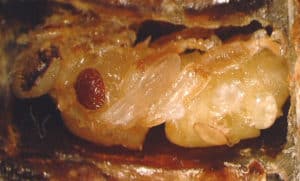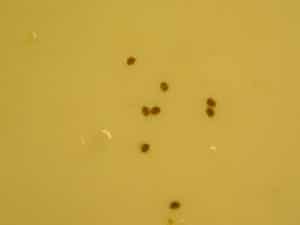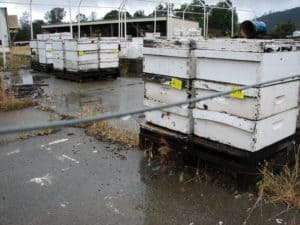
I am going to save my original topic of propolis and bee health for a later weeks since it seems more apt to talk about Varroa this time of year. Late summer and early fall is the time when many beekeepers treat for Varroa. Treating now reduces the number of mites feeding on the bees that will become winter bees. One symptom of a mite feeding on a worker pupa is a shortened life span for that adult bee. So, if too many winter bees are exposed to mites during their development, then the population of adult bees can die off over the long winter.

Before you decide to treat, test for mites to be sure the colony actually needs a treatment. It is in yours and the bee’s best interest to only use chemicals in the hive if you need to. To test for Varroa, I like the powdered sugar roll. I am not going in to how to sample in this blog since Gary Reuter and I put together a poster with how to do a powdered sugar role here. (As a side note, in the poster I use 0.42 cups to measure 300 bees since I compress the bees through rapping the cup down on a hard surface. However, you can use 1/2 cup to measure 300 bees if you don’t rap the cup down but shake the cup so it is about even on top.) You can use other methods to test, too. Randy Oliver recently had a pretty good article about sampling that describes an alcohol wash method that works quite well and there is the sticky board method. I would stay away from the ether roll since it is the least accurate. There is lots of literature online about different ways to sample. The most important thing is to sample and to be consistent in the way you sample. Consistency allows you to compare a colonies mite levels among your own colonies and potentially with other beekeepers if they sample in the same manner.
Once you get a count of the mites what does it mean? Well, if you do a powered sugar roll or alcohol wash and find 9 mites in a 300 bee sample then the colony has about a 3% infestation on adult bees. Assuming there are 40,000 bees in the colony, then there are about 1,200 mites on adult bees. However, there are also mites hiding under the capped pupal cells. To account for these mites you need to multiply by two, so 3% infestation on adult bees means a 6% infestation in the whole colony.
Now what to do with the colony mite level? When do you treat? Oh do I wish I had the answer to this, but I don’t. Some research says to treat at a 10-12% colony infestation, but I’ve talked to beekeepers that think it should be less than 3%. Neither is wrong for certain situations. Thresholds are regional since they largely depend on how long the brood rearing season is and thresholds are dependent on the type of beekeeper. The colonies of an isolated hobbyist in the north could maybe withstand a 10-12% infestation, but colonies of a migratory beekeeper in Texas may need to use the 3% infestation threshold.

Sample and learn more about your bees. Keep records so you can compare each year – record the mite levels before treatment, if you apply a treatment and what you use, then sample and record the mite level after the treatment. By recording you will learn more about your colonies and what works to keep them alive and what doesn’t. I know I have serious issues accurately remembering that far back. Mark your colonies so you can follow them over time.
Even if you don’t use treatments, I would recommend to still sample and keep records. You never know what you will find.